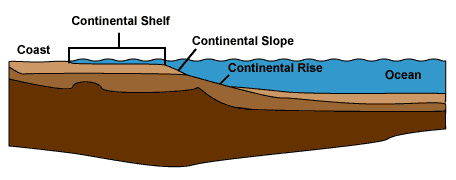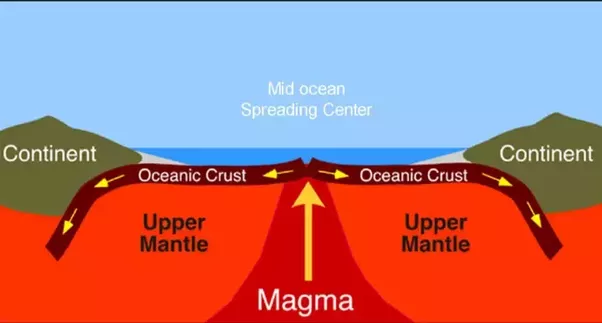Oceanic Landforms
Our knowledge of the features underneath the oceans is far less and more recent than that of the features on the surface of continents. We, however know that the average dept of the oceans is about 4000 meters and that the oceans are much deeper than the land is high. The highest mountain peak, Mt Everest, 8840 metres high can be submerged into the deepest ocean trench which is Mariana trenc 11000 metres deep, with over 2000 metres of space to spare. We also know that the ocean floor is made up of three zones:
- the continental margin.
- the ocean basin floor
- the mid-century ridge.
The continental margin
The continental margin is made up of the same rocks (sail) as the continental landmass. It starts from the shore and runs through the continental shelf, and then plunges down the continental slope to the continental rise.
We will examine this one after the other.

Credit
Shore: the shore sometimes called the littoral or coast, is the narrow belt between the highest and lowest levels where the tides reach. Beaches develop here, and also it is homes to animals such as crabs and other molluscs.
The continental shelf: this is abroad shallow zone, immediately after the lower shoreline generally not deeper than 180m and with a gentle slope. The surface is covered with sediments derived from the adjoining continental landmass. The width varies, it is generally narrow where mountain ranges are close to the sea, like what we have off the west coast of North and South America where it is less than 5km wide. Otherwise it is broad, like off the coast of Siberia and Japan. Here it is over 1000km wide. The continental shelf is formed either by the submergence of broad coastal plain, or deposition of materials from the continents.
The continental slope: the continental slope is about 20km wide, has very steep gradient and is characterised by several submarine canyons probably eroded by turpidity currents of under- water moving fast down the slope.
continental rise: beyond the slope is the continental rise, having similar shallow gradient as the continental shelf, but much narrow, about 20km wide.
The ocean basin floor.
The ocean basin floor, also referred to as the deepsea floor, is made up of the oceanic crust (sima). Three special features are found here, the abyssal plains, volcanic islands, and deep sea trenches*.
Abyssal plains: are formed by the accumulation of sediments eroded away from the submarine canyons and deposited on the sima.
Volcanic islands: volcanic islands rise from the sea floor and surface in areas like Azores, Ascension, Tristan da Cunha, and St Helen Islands, all in the Atlantic Ocean. Where these islands are conical and submerged, they are called seamounts, but where they are flat-topped and submerged, they are referred to as guyots.
Deep sea trenches: these are long, narrow, steep-sided and deep trenches located at the subduction zones where two convergent tectonic plates meet.
The mid-ocean ridge
This consists of a long continuous mountain range or plateau on the sea floor. The nearest to my country (Nigeria) is the mid-Atlantic Ridge which runs through the middle of the Atlantic Ocean. Other are the mid-Pacific and mid-Indian Ocean Ridges.

Credit
At the middle of the ridge is a central submarine rift valley which is a long crack or fissure created where two divergent tectonic plates are pulling apart. New magma from the mantle underneath pours out to the ocean floor through this long opening.
Sea floor deposits
These consist of mud, clay and oozes. The last are shells and skeletons of dead microscopic sea animals which accumulate to form coral reefs. The coral islands of East Africa and the Great East Austrailian Barrier Reef are some of the world most notable examples.
Reference
National Geographic
Geologic Landforms of the ocean
My gormorphology lecture notes
You received a 80.0% upvote since you are a member of geopolis and wrote in the category of "geography".
To read more about us and what we do, click here.
https://steemit.com/geopolis/@geopolis/geopolis-the-community-for-global-sciences-update-4
Thanks for this lesson. I have always wondered about such occurrences as how the continental drift came about and if land bodies existed underwater
Thanks for reading, we are yet to fully explore the bottom of the sea due to the depth. With time more mystery will reveal itself.